|
|
 |

|
Russia,
Mongolia & China (by train & horse) |
 |
 |
|
|
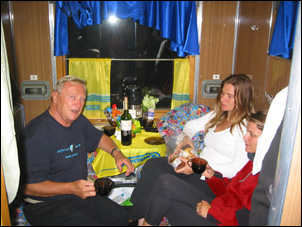 No
motorcycles, for a change, but lots of trains and horses this
time. My father had been planning for a while to take a trip
on horseback in the Gobi Desert and he had invited us along.
As we had also been planning for a while to cross Asia by
train aboard the famous Transsiberian, it seemed an obvious
solution to combine the two. My sister Anne had decided to
join us, so the four of us set off end of August 2003.
No
motorcycles, for a change, but lots of trains and horses this
time. My father had been planning for a while to take a trip
on horseback in the Gobi Desert and he had invited us along.
As we had also been planning for a while to cross Asia by
train aboard the famous Transsiberian, it seemed an obvious
solution to combine the two. My sister Anne had decided to
join us, so the four of us set off end of August 2003.
After
flying to Moscow, we boarded our train, spending four nights
aboard before arriving in Irkutsk in order to visit Lake Baikal
where we did some sightseeing for a couple of days. There
are however not very many sights to see, other than the natural
spectacle of Lake Baikal itself. Our guides at one point proudly
announced the visit of a cave which turned out to be a railroad
tunnel that looked very much like … well, like a railroad
tunnel. After the visit, they asked if we would like to see
another one. We declined.
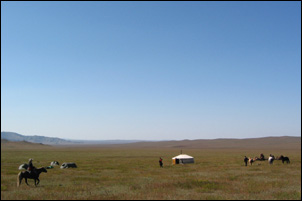 Also,
there was a « Locomotive museum », which consisted
of two rusty locomotives parked on an abandoned rail. Probably
very interesting for someone passionately interested in rusty
locomotives, but our interest crumbled relatively fast under
the combined assaults of rain and ridiculous numbers of mosquitoes.
Despite those slight cultural setbacks (or maybe because of
them), we very much enjoyed ourselves. One highlight was certainly
a visit to a typical Siberian sauna where we were busy for
several hours sweating, getting flogged (gently, that is),
dunking ourselves in Lake Baikal (about 3 C) and drinking
infused Vodka. By the end of the first bottle, we started
having doubts about the medical advisability of the Siberian
technique but who are we to argue.
Also,
there was a « Locomotive museum », which consisted
of two rusty locomotives parked on an abandoned rail. Probably
very interesting for someone passionately interested in rusty
locomotives, but our interest crumbled relatively fast under
the combined assaults of rain and ridiculous numbers of mosquitoes.
Despite those slight cultural setbacks (or maybe because of
them), we very much enjoyed ourselves. One highlight was certainly
a visit to a typical Siberian sauna where we were busy for
several hours sweating, getting flogged (gently, that is),
dunking ourselves in Lake Baikal (about 3 C) and drinking
infused Vodka. By the end of the first bottle, we started
having doubts about the medical advisability of the Siberian
technique but who are we to argue.

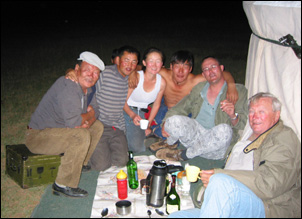 We
boarded the next train and after two more nights, we arrived
in Ulan Bator, Mongolia where we met our guides (and interpreter)
for a one week horse ride through the Gobi Desert. There is
only so much terrain you can cover in a week and we basically
only saw the edge of what constitutes the Gobi Desert, but
even so, it was spectacular. We rode between five and seven
hours every day, through hills and plains dotted with the
occasional lake. The Northern Gobi is mostly a scrub desert
although there are some dunes. Our luggage and supplies were
transported by camel cart that would take the shortest route
while we rode detours. At the end of each day, a ger (Mongolian
felt hut) would be set up and we would tend to the difficult
business of communicating directly with our hosts, a task
that became easier as the days went by. We were very impressed
with the horses as well as the horsemanship of the Mongolians,
most of which looked very much the way we pictured their ancestors
riding with Genghis Khan.
We
boarded the next train and after two more nights, we arrived
in Ulan Bator, Mongolia where we met our guides (and interpreter)
for a one week horse ride through the Gobi Desert. There is
only so much terrain you can cover in a week and we basically
only saw the edge of what constitutes the Gobi Desert, but
even so, it was spectacular. We rode between five and seven
hours every day, through hills and plains dotted with the
occasional lake. The Northern Gobi is mostly a scrub desert
although there are some dunes. Our luggage and supplies were
transported by camel cart that would take the shortest route
while we rode detours. At the end of each day, a ger (Mongolian
felt hut) would be set up and we would tend to the difficult
business of communicating directly with our hosts, a task
that became easier as the days went by. We were very impressed
with the horses as well as the horsemanship of the Mongolians,
most of which looked very much the way we pictured their ancestors
riding with Genghis Khan.
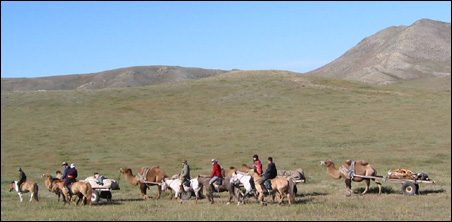 By
the end of the week, we were all suffering from severely sore
bottoms (with the possible exception of my father, at least
he wouldn’t admit it) but we regretted that we didn’t
have more time to spend with those people. There are not many
real nomads left on earth and their lifestyle is slowly but
inexorably changing, even if Mongolia’s infrastructure
is perfectly suited for them as there is hardly a fence in
the whole country.
By
the end of the week, we were all suffering from severely sore
bottoms (with the possible exception of my father, at least
he wouldn’t admit it) but we regretted that we didn’t
have more time to spend with those people. There are not many
real nomads left on earth and their lifestyle is slowly but
inexorably changing, even if Mongolia’s infrastructure
is perfectly suited for them as there is hardly a fence in
the whole country.
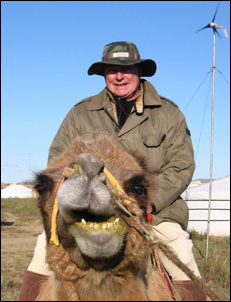 A
final shopping binge and some sightseeing in Ulan Bator were
followed by another 36 hours by train in order to get to Beijing
from where we flew home. Beijing was a surprise : Ultramodern
architecture, interesting sights, great shopping, easy communication,
and good food but terrible service are the sum of the few
impressions we could gather in our 36-hour stay.
A
final shopping binge and some sightseeing in Ulan Bator were
followed by another 36 hours by train in order to get to Beijing
from where we flew home. Beijing was a surprise : Ultramodern
architecture, interesting sights, great shopping, easy communication,
and good food but terrible service are the sum of the few
impressions we could gather in our 36-hour stay.
As for
the Transsiberian, the total by train came to just over nine
thousand kilometers, most of which were fairly comfortable,
somewhat in contrast to our usual method of transcontinental
travelling. Different but very pleasant. It was interesting
to witness the different interpretations of customer service
by the various train attendants during the consecutive legs
of the journey : The Russians were exquisitely rude, the Mongolians
were easily exasperated by uncomprehending tourists but ultimately
pleasant and the Chinese were very polite. A train is a good
place for people watching, both on and off the train, as there
are regular stops (although most of them short), allowing
for at least some rudimentary interaction with whatever locals
happen to be in and around the train station. We still prefer
travelling by motorcycle but riding trains has some advantages.
We might do it again.